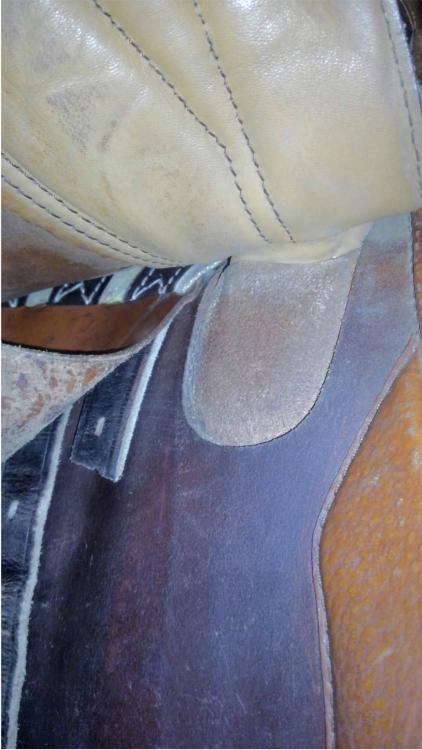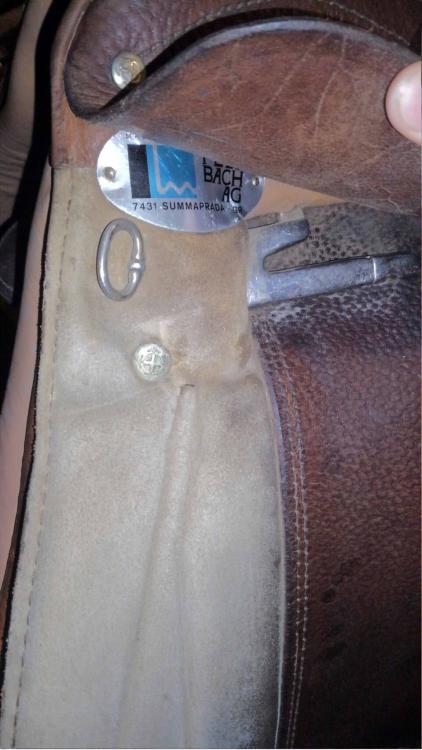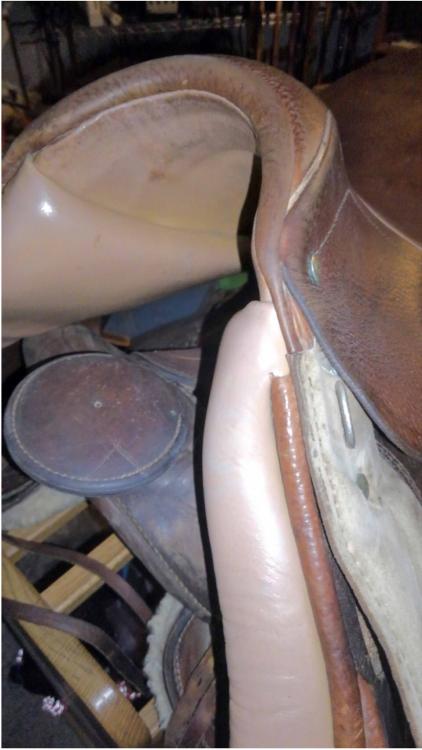-
Posts
48 -
Joined
-
Last visited
Profile Information
-
Gender
Female
-
Location
Nebraska
-
Interests
Music, Horses, Arts&Crafts, Fun Times
LW Info
-
Leatherwork Specialty
Horse Gear
-
Interested in learning about
Horse/Riding Gear and anything fun
-
How did you find leatherworker.net?
Googling eco-flo all in one dye
Recent Profile Visitors
The recent visitors block is disabled and is not being shown to other users.
Wild Huntsman's Achievements

Member (2/4)
-
No, you see, the problem for me is I don't know how to safely drop the panel on the english saddles with the single roll on the pommel. I USUALLY just drop the front of the panels to do the billet replacement. The back side doesn't look terribly inviting to work with either as far as putting it back together after popping stitches. Which is why i was looking at just pulling the rivet, but if it's actually clinched on the other side... I'm not sure how to approach this? I can replace all but the front most billet without messing with anything else but the goal is to replace them all. :\
-
I haven't posted in these forums for quite some time so hoping it's still fairly active. I got this saddle in for billet replacements but I've got the issue of not being sure how to drop the panels on an english saddle with the single roll up front, and I would just wiggle the needle up in there but this second rivet/tack is holding the flap down too tightly to get to the front billets(they all need replaced on both sides). I'm not sure if there is a tool that can safely get under the rivet, or if someone knows where to pop seams along the front on a single roll saddle and still be able to put it back together or do I need to just tell them that front billet is a lost cause? Any help would be greatly appreciated; I've done billet replacements before but the saddles always had the double roll up front where you can easily pop and replace the stitching to just drop the underside down and out of the way.
-

Run Of Spur Straps
Wild Huntsman replied to Round Brim Hat's topic in Saddle and Tack Accessory Items
Hmmm. Guess I'll have to dig up a pattern somewhere and give them a shot. I do like that there's more room to make them decorative while staying functional. -
Thankyou! Tt does help, though I think id have to drop the weight for the layered sections a bit. Hands hurt just thinking about getting a needle through all that(no machine)!
-

Run Of Spur Straps
Wild Huntsman replied to Round Brim Hat's topic in Saddle and Tack Accessory Items
Like the look of them! That dove wing style seems like it's getting fairly popular. Do they really work well?? -
@Round Brim Hat, they didn't specify why they wanted one, just that they had been considering doing it themselves but had no tools or experience. Most things i found on the internet say with maintenance they can last a long time, but without proper care it sounds like they last a few months. Though also through internet browsing, it sounded like the people who do use them like them as an alternative to rubber/nathe/etc when trying to avoid metal mouthpieces or going bitless altogether. @awharness I'd be sure to let them know there's a chance it'll wear through fast depending on the variables. I was also thinking wrapping it with another lighter weight piece around the mouth portion might help delay major chew damage? Was also considering trying to line it where the rings would go, but not sure... @AdamTill, yes. This is why I was hoping to find out if anyone knew where to get hold of more "cleanly" tanned, durable leather. Meroth leather bits boast being 100% chemical free, so I was rather hoping they didn't get all their leather custom tanned...
-
Hey there forum folks, been a while. Someone just asked me about making them a leather bit, and the construction should be simple enough, except that I'm not 100% sure what leather to use. I certainly don't want something that would be harmful to have in the mouth, but also want to be sure the leather will be able to handle the conditions of being in a mouth. Is vegetable tanned the best way to go? Is there a good strong leather that's tanned without any harmful chemicals at all that wont cost an arm and a leg to get hold of? If someone knows or could give some input, it'd be greatly appreciated!
-

My Very First Browband Headstall Ever!
Wild Huntsman replied to LeenieBean's topic in Saddle & Tack Maker Gallery
Looking better with the adjustments. I'm also more used to English equipment, and always think Western tack could use some strap keepers. If it helps any with the browband measurements in the future, add 8-10" to what you think the finished size should be, and if you're using a wider crown piece or having separate crown/throat slots, a couple more extra inches on top of that will help to start from. Easier to take away as you go than get to the finished product and find you need more! -
That is quite awesome, definitely need a picture of it being worn; good work!
-
AdamTill, thankyou for the link to the other link! That will be very useful! fivewayswelshcobs, thankyou for letting me know about the staples. I was already aware webbing is what is normally used from deconstructing two worn out saddles--which is how I go the wood and steel tree--and the very scarce youtube videos I could dig up. I was more asking if it would be detrimental to build up the seat like one does on a western saddle. The plastic tree did not cost me very much, so I was thinking about trying it that way if it wouldn't botch the whole thing.
-
I would also like to know if it would be an especially bad idea to build the seat up like one does for a western saddle. I probably wouldn't on the wood and steel one, but maybe for the plastic one...??
-
Hello there, been a while since I shared something, so here are the last two bridles I finished from last year. I'm sorry there aren't better pictures of the black one, I only have those images because I was able ot ask for them from the person I sent it off with. They could both be a bit better I'm sure, and the construction is a bit odd but it's hard to tell where adjustments went in those old illuminations! The throat and cheeks are one piece on each side and adjust at the top and at the bottom. The black one is made from black latigo, and the red from vegetable tan that was dyed with eco-flo all in one, since it was handy. Not sure how many I'll make in this style, since the adjustment is a bit awkward, but they were relatively simple and are kind of fun regardless.
-

My Very First Browband Headstall Ever!
Wild Huntsman replied to LeenieBean's topic in Saddle & Tack Maker Gallery
For a first bridle that doesn't look half bad at all! Certainly more to look at than my first. But I do agree with the others; those cheek pieces are quite long. The crown is a hair short and the throat may be also? I'm not used to large buckles myself, so I'll just say that if they're staying out of their eyes, and not pushing into their ears they are probably alright. Keep up the work and remember, measure 20 times and hopefully cut once! ;P -
Hello, I have a couple English style trees I'm wanting to build on. One of them was pulled from a worn out synthetic and is fiberglassed wood and steel(it is sturdy still), and the other I found on ebay and is some type of plastic(never built on). I would buy trees from an actual suplier but I don't know where one acquires English trees. Regardless, my question is does anyone know how to build onto the plastic tree?? Is it safe to put tacks or staples into? If not, how would one go about attaching the webbing for the billets to it, and the rest? I have not made a saddle before, and I do not know of anyone that isn't several states away(or countries) who knows how to construct an English saddle, I can't even find a local person to reflock them. I'm hoping there's someone on here who is able to help answer, otherwise I suppose experimenting on the plastic tree will have to do.








